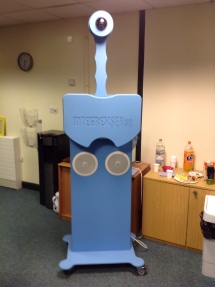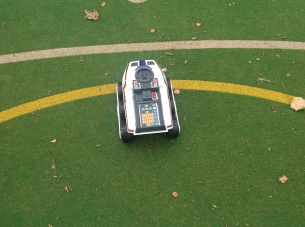Blog Archives
A Gesture of Hope – Using Gesture-Based technology with SEN – #BETT15 Learn Live SEN
Around 3 years ago, I wrote this blog post about Tech Ideas for SEN and this is when Anthony Rhys contacted me via Twitter about the use of gesture-based technology in his school. I can’t find his original tweet but here is the reply to it –
@trinityfieldsit just look at your wiki, fantastic resource. Will reply to email on Monday but some great stuff you are doing!!
— James Winchester (@jwinchester25) April 29, 2012
This conversation via Twitter led to the creation of the Gesture-Based Technology PLC and since then this has grown to include many different schools and practitioners.
At BETT, Anthony and myself were fortunate to present on the work that we have done with Gesture Based Technology and how it has had a huge impact on the lives of the complex learners that we work with. At the end it was nice to reflect on how much the PLC had achieved and also looking forward to the next steps especially using video analysis more effectively with SEN students. (see link – http://videoanalysissen.wikispaces.com thanks to Andrew Walker for his excellent work in starting this up. )
Below is the link to the prezi which gives a quick overview of the work that has been done – it was great to be able to share the work of the PLC and looking back its is quite unbelievable that we have achieved so much in such a short period of time.
http://prezi.com/k2v5ap16hdr0/?utm_campaign=share&utm_medium=copy&rc=ex0share
KinectSEN – exploring gesture based technology to engage all learners
Last Thursday, I had the pleasure to be invited to be part of the professional learning community (PLC) looking into gesture based technology and the impact it can have on special needs learners. Gesture Based Technology (GBT) includes technology that involves a natural user interface for its input. This can be the Kinect, iPads, Eyegaze, mobile floor projectors to name a few of the technologies and is mainly used at present in gaming consoles at home. The power of natural user interfaces is that is allows students with SEN to be included in sessions and enable them to explore movement, creativity and engagement. From the evidence that I have seen so far, it gives students an opportunity to be actively involved in effecting their environment and allows them to do things that they simply could not do before. What is great to see is the instant effect that students have using this technology and this achieved by them moving in whatever way they can.
Over the next few months, I will be hoping to blog the progress that has been made in incorporating GBT into our schools and present evidence for this. I came away from the day even more enthused to make this happen and it was great to meet other practitioners just as interested in the technology to help engage thise student with severe learning difficulties. We are currently looking into adding this to our sensory room so that we have an interactive floor and wall display at the fraction of the cost that some SEN companies would charge.
If you are interested in GBT and the use of the Kinect and would like to find out more about how different schools are incorporating this technology please visit the Kinect Wiki site at http://kinectsen.wikispaces.com/
Using innovative technologies in the classroom – The Echoes Project
This post is the third in a series of posts on the Festival of Social Sciences – Using Innovative Technologies in the Classroom event that took place in Birmingham on Thursday 8th November. You can view the first post here and the second one here.
The Echoes project

Echoes is project led by Dr Kaska Porayska-Pomsta from the Univertisty of London with the focus to support children on the autistic spectrum with their social communication skills in particular joint attention. Many autistic children fail to pick up on the social cues given by others which can often lead to misunderstandings for many children in the spectrum.
She realised that technology could have a role to play in supporting children in developing these essential social skills and so developed the Echoes project. The idea is to provide children with an environment for them to practise these skills on something that isn't human and isn't going to take offence.
Echoes uses touch screen technology alongside cameras to pick up information from the user so that the virtual autonomous agent Andy can react appropriately to their input. Andy's traits are preselected by the team which determines how he reacts to the information he receives. In addition the cameras allow him to understand where the child might be looking. His personality has been built using artificial intelligence which enables him to react differently to different children. Depending on the child's development, Andy will react differently and adapt his actions accordingly. For example, if a child touches an object frequently, Andy might think the child likes that object and then would concentrate on using that object in different activities.
By observing children playing with Andy, it allows teachers to gain a better understanding of a child's strengths and weaknesses and explore questioning in relation to learning and development. I really enjoyed having the chance to experiment with the technology and Andy would instantly show me what the activity was and also signed in makaton to promote further interaction.
What really excites me with this project is the plans for the future. Kaska explained they are exploring different routes to open up the accessibility of the project. One use could be through using the Microsoft Kinect and using the tracking capabilities of this technology alongside Eyegaze cameras. This would be something that in my particular setting would be of great benefit as it opens up the project to wide range of students.
After having the chance to play with the project I left feeling that this technology could benefit many students in enabling to practice social skills, interaction and co-operation in a safe environment to prepare them for transferring these skills into real world contexts.
Related Links
The SHAPE project, technologies to enhance learning for young people on the Autistic Spectrum
Using Innovative Technologies in the Classroom – COSPATIAL Project
This post is the second in a series of posts on the Festival of Social Sciences- Using Innovative Technologies in the Classroom event that took place in Birmingham on Thursday 8th November. You can view the first post here.
The COSPATIAL Project
The main emphasis of the COSPATIAL project is finding ways to adapt existing classroom technologies to engage children with autism in learning social skills. The project is being led by Dr Sarah Parsons of the University of Southampton and Dr Sue Cobb of the University of Nottingham. Thanks go to Dr Sarah Parsons for talking us through the project and although we did not get to see the project in action it was clear to see how the technology would be used with Autistic Spectrum Condition (ASC) students.
The COSPATIAL project focuses on two types of technologies:
- Collaborative Virtual Environments
- Shared Active Surfaces
In this post I am going to concentrate on the Collaborative Virtual Environments. These allow multiple users to interact and communicate within a shared virtual space. They do this by accessing the space on individual laptops that are in the same room. There are 3 different programs that the students can use each working on different elements of social interaction from communication to working together to complete a task.
Talk2U – students communicate with the support of the teacher to help explain social conversation. The students press the the buttons on screen to communicate with each other and this can be on a variety of different topics.

Talk2U – Students can practice social conversation with the support of the teacher
Block Challenge – the students work together to build a tower of blocks. The students have to communicate with each other to complete the task. Again this task looks to promote skills that students on the Autistic Spectrum tend to need support with.

Block Challenge – where students work together to build a tower of blocks
Face2Face – Students communicate in a shared environment using video avatars. The space is flexible and can be adapted for different users and activities.
I felt that this project is really interesting as it allowed students with ASC to work in an environment that enables them to communicate and collaborate through a safe and comfortable medium. The idea of the project is to give the students a space to practice these skills before moving them onto to real-life interactions which can be extremely daunting for students with ASC.
What I also like about this was that they are using existing technology and the application can run on a variety of machines. Unlike some high-tech solutions on the market this application would benefit many school running on a limited budget.
Links –
The COSPATIAL Project – http://cospatial.fbk.eu/
The SHAPE Project, technologies to enhance learning for young people in the Autism Spectrum – http://opensen.wordpress.com/2012/11/10/shape-project-the-future-landscape-of-technologies-assisting-young-people-with-autistic-spectrum-condition/
Next Post – Echoes Project
Using Innovative Technologies in the Classroom – Big Trak
This post will be the first of a series of posts on the Festival of Social Sciences- Using Innovative Technologies in the Classroom event that took place in Birmingham on Thursday 8th November. The festival showcased a variety of technology that was being used to enhance learning. The original focus for the technology was aimed at students on the Autistic Spectrum, but the researchers and schools trialling the technology have seen benefits for all students. A big thank you goes out to Anthony Rhys of Trinity Fields School who put us in contact with Dr Wendy Keay-Bright of University of Wales Institute, Cardiff who invited my colleague Keith Manville and myself to the event. Lastly, a thank you needs to go to Dr Karen Guldberg from The Autism Centre for Research and Education, University of Birmingham for organising the event and Ian Lowe head teacher of Topcliffe Primary School for hosting us at his school.
One of the purposes of the event was to showcase the SHAPE project. The SHAPE project is where researchers and practitioners are working closely together to identify ways of using four different technologies in innovative and exploratory ways. Technology enhanced learning (TEL) can offer significant benefits for children on the Autistic Spectrum and the project looks at conducting research in the classroom focusing on social interaction and communication. The technologies involved are
- COSPATIAL
- ECHOES
- Reactikles
- SOMANTICS
In addition, Aldebaren-Robotics were showcasing their NAO robots and you can read more about these in the BBC report here.
For this first post however, I decided to actually write about something that is not that innovative (first released in the 80s) but has a lot of uses for teaching students some important skills.
Big Trak – Control technology
This is something that I feel students with SEN could easily learn to use and is a useful piece of technology to enhance their learning.
Next Post: COSPATIAL – Collaborative Virtual Environments.
Links –
Keith Manville @open_sen has also written up about the event and you can read his excellent post here.




